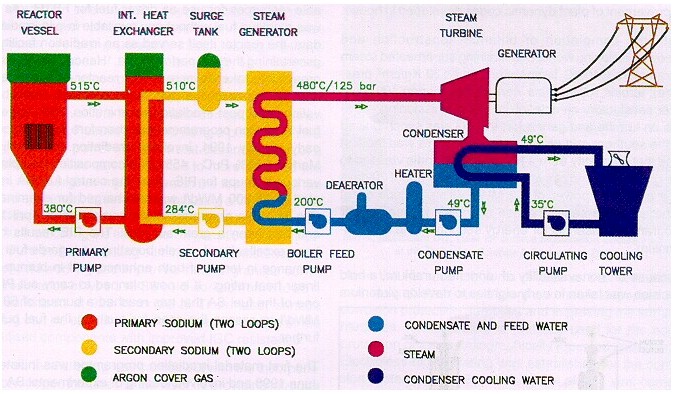FAST BREEDER TEST REACTOR
The feasibility of the design, construction and operation of FBRs under Indian conditions has been proven by the successful construction and commissioning of Fast Breeder Test Reactor [FBTR], a 40 MWt/ 13.2 MWe, loop type reactor using sodium as coolant. Though the basic design is based on the French reactor "RAPSODIE", several modifications including addition of steam generators for power generation were made to suit our requirements. It uses a unique Plutonium-Uranium mixed carbide fuel developed indigenously. The fuel has achieved a burn-up of 40000 MWd/t (as on Oct. 1997); there has been no fuel pin failure so far. FBTR has reached an important milestone, when it was synchronized with the southern grid for the first time on 11th July 1997, thus establishing the indigenous capability for generating electricity through FBRs. The reactor is mainly used as a test-bed for irradiation experiments on fuels and other reactor materials.
|
CHARACTERISTICS |
|
|---|---|
|
REACTOR COOLANT |
: SODIUM : LOOP : 40 MWt : 13.2 MWe : 70 % PUC-30 % UC [MARK I core] : 320 mm : 380 deg.C : 515 deg.C : 150 TONNES : 490 deg.C at 167 BAR : 6 NOS. OF BORON CARBIDE : 3 X 10 15 n/sq.cm/sec |

|
MILESTONES ACHIEVED |
|
|---|---|
| 18th
OCTOBER 1985 1989-92 MARCH 1993 DECEMBER 1993 11th JULY 1997 |
: FIRST CRITICALITY : OPERATION AT 1MWt : POWER RAISED TO 10.5 MWt : 1.6 ATOM % BURN UP ACHIEVED WITHOUT FUEL FAILURE : SYNCHRONIZATION WITH SOUTHERN GRID |